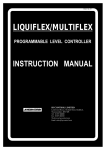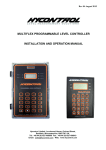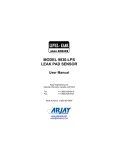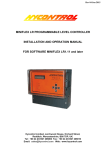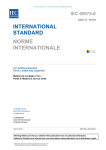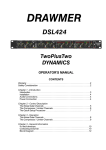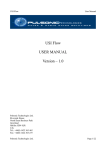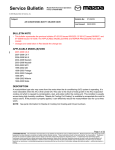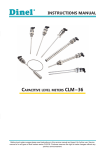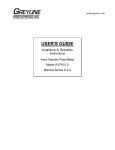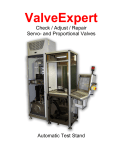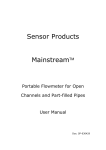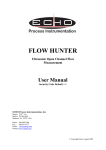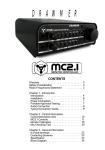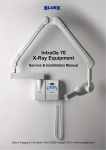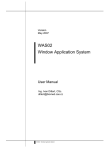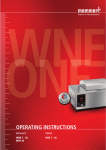Download multiflex wall mount
Transcript
Elect. Iss. 01 LIQUIFLEX MULTIFLEX PROGRAMMABLE LEVEL CONTROLLER PROGRAMMABLE LEVEL CONTROLLER INSTRUCTION MANUAL INSTRUCTION MANUAL HYCONTROL LIMITED Larchwood House, Orchard Street, Redditch, Worcestershire, B98 7DP. Tel: 01527 406800 Fax: 01527 406810 Web: www.hycontrol.com Email: [email protected] MULTIFLEX USER MANUAL - INDEX Page Section 1 Introduction 1 Installation Transceiver Mounting Transceiver Wiring Transducer Mounting Transducer Alternative Mounting Transducer Mounting Faults Transducer Stand Pipe Transducer Cable Extensions 2 2 3 4 5 6 6 7 Drawings Fig. 1 Fig. 2 Fig. 3 Fig. 4 Fig. 5 Figs. 6 & 7 Temperature Sensor 8 Section 2 Easy Start for Liquiflex Quick Start Guide Principle of Programming Keypad Definitions To View Parameters Programming Example Programme Checking & Correction 9 9 9 10 11 12 13 Section 3 Programming Principle of Programming Keypad Definitions Display Descriptions Security Code Application Programming Entering a New Programme 14 14 14 14 15 16 17 Section 4 Parameter Index Parameter Definitions Section 5 Examples 1. Level Measurement Mode 2. Contents, Volume Conversion 3. Pump Control 4. Differential 5. Open Channel Flow 6. Open Channel Flow with Penstock 35 35 36 37 38 39 40 Section 6 Commissioning Fault Finding 41 APPENDIX 1 LINEARISATION OF SPECIAL VESSESLS OR FLUMES 45 APPENDIX 2 SERIAL COMMUNICATIONS 49 APPENDIX 3 SPECIFICATION 51 APPENDIX 4 PARAMETER SETTINGS 52 MULTIFLEX MANUAL EDITION 2 : NOV 2000 18 19 to 34 Fig. 8 SECTION 1 ULTIFLEX PROGRAMMABLE LEVEL CONTROLLER USER MANUAL INTRODUCTION Multiflex Multiflex is a programmable multi-purpose level measurement instrument suitable for both solids and liquid applications. It consists of two elements, a wall mounted transceiver which has a display and an integral keypad for programming, and a transducer which must be mounted directly above the surface to be monitored . Ultrasonic pulses are transmitted by the transducer to the surface of the product to be monitored and are reflected back to the transducer. The time period between transmission and reception of the sound pulses is directly proportional to the distance between the transducer and the product. Since the speed of sound through air is affected by changes in temperature, a separate or integral (in the transducer) temperature sensor may be fitted to improve accuracy. Multiflex is capable of the following functions:a) Level Measurement (height above datum) b) Distance Measurement (distance from datum) c) Volume Measurement d) Differential Level Measurement e) Open Channel Flow Measurement (O.C.M.) f) Pump Control WARNING DO NOT OPEN THE TRANSCEIVER DOOR WHEN THE POWER IS ON TO THE SUPPLY OR RELAY TERMINALS. MULTIFLEX MANUAL EDITION 2 : NOV 2000 1 SECTION 1 INSTALLATION Transceiver Wall Mount - Figure 1 Undo the 6 quarter turn screws on the front panel and open the hinged door to expose the mounting holes. Mount the unit on a flat surface and secure it via the 4 mounting holes moulded in the enclosure. DO NOT use excessive force when tightening the fixings and avoid any distortion of the enclosure. Ensure that the mounting surface is not subject to vibration and is not close to high voltage cables, contactors or drive controls. The unit should not be mounted in a confined space where temperatures may exceed the normal working temperature. If the unit is mounted outside it must be protected from direct sunlight and severe weather conditions. Remove the required number of hexagon blanking plugs from the bottom of the enclosure and replace them with appropriate conduit hubs or cable glands to maintain the I.P. rating. Figure 1: 10 160 130 CTRS MULTIFLEX RELAY 3 RELAY 1 RELAY 4 RELAY 2 RELAY 5 HYCONTROL PROGRAMMABLE LEVEL CONTROLLER HI.TO LO.TO 2 1 R1.HR R2.HR 3 R3.HR 6 7 R2.ST R3.ST 5 R1.ST HEAD 9 0 . R5.HR MULTIFLEX MANUAL EDITION 2 : NOV 2000 4 R4.HR 8 R4.ST - GAIN CE # MODE TEST R5.ST TEMP DIST mA DSP ENT 40 3 HOLES 20 DIA PLUGGED FLOW 240 228 CTRS HYCONTROL 40 40 4 MOUNTING HOLES 4.3 DIA (UNDER LID) 2 90 SECTION 1 Electrical Connections - Figure 2 The instrument has two-part screw terminals. It can be powered from either an AC or DC supply. Figure 2: AC POWER 110/230 VAC +10%/-10% 19 20 4 5 6 7 8 9 10 11 12 13 14 15 16 17 18 TRANSDUCER 50/60 HZ 12VA RELAY 1 RELAY 2 AC power supply connected:- RELAY 3 RELAY 4 Earth Neutral Live 21 22 23 24 25 26 + SHIELD L L1 SHIELD 3 N L2 HOT.BLUE 2 E BLACK 1 27 28 + TEMP SENSOR ISOLATED ANALOG OUTPUT DC POWER 21.6-30VDC 9W RELAY 5 to terminal 1 to terminal 2 to terminal 3 The instrument will automatically select either 110V or 230VAC ±10%, 50Hz or 60Hz, 12VA. A time lag fuse T160mA is fitted. DC power supply - connected :- Positive +ve to terminal 27 Negative -ve to terminal 28 The instrument will accept 24VDC + 25%, - 10%. 9W. A time lag fuse T315mA is fitted. 5 SPDT Relays - rated at 8A/250VAC/30VDC resistive, with gold contacts for lower power switching, are connected at terminals 4 to 18, for activating external alarms, contactors, pumps etc.. Transducer RXV15 - is connected:-Black Blue Screen to terminal 19 to terminal 20 to terminal 21 Temperature compensated transducer RXT15 (Screen Must enable Pr.37 (Blue (Black is connected:to terminal 19 to terminal 20 to terminal 22 Isolated Analogue - is connected :- Screen to terminal 24 Positive +ve to terminal 25 Negative -ve to terminal 26. Separate Temperature Compensation - when compensation is provided by a separate temperature sensor, the sensor should be connected with a shielded twisted pair and connected:( Screen to terminal 21 Must enable Pr.37 ( Core* to terminal 22 ( Core* to terminal 23 * The polarity of the cores is unimportant, but it is important that the screen is connected only at the instrument end and not at the temperature sensor end. MULTIFLEX MANUAL EDITION 2 : NOV 2000 3 SECTION 1 Transducer Mounting The transducers can be supplied separately or mounted in a Teflon faced flange for applications requiring chemical compatibility. Figures 3 and 3a show the dimensions: Figures 3 and 3a: M20 x 1.5 20 10m cable 6.9 dia 170 21 Isolation Kit Fit as shown No. & size of bolts to suit flange selected 95 20 100 50 72 Bolt hole PCD to suit flange selected Dia to suit flange selected An isolation kit is provided with each transducer to minimise any ringing transmitted through the mounting structure. Its use is optional on flanged transducers (for terminating conduit). The transducer must be mounted perpendicular to the monitored surface and, ideally, at least 0.5 metres above its maximum level. The transducer has a 10° inclusive conical beam angle at 3dB and must be mounted with a clear unobstructed sight of the product to be measured, over the complete measurement range. The beam "footprint" = approx. 20% of the distance to the product. The transducer is provided with integral cable which can be extended up to 300 metres using a suitable junction box and RG62AU cable for the standard transducer. The temperature compensated transducer requires an additional single core screen extension. Alternatively you can use screened twin-axial Beldon 9207 or equal for either type of transducer; refer to Fig.6. Transducer cables and temperature compensation cables can be run together but should be separated from power cables by at least 150mm and preferably installed in their own earthed steel conduit. MULTIFLEX MANUAL EDITION 2 : NOV 2000 4 SECTION 1 Figure 4: Alternative mounting arrangements for transducers FLEXIBLE OR RIGID CONDUIT. UNDER FLANGE. BRACKET. ISOLATION KIT. ISOLATION KIT. SLIP-ON FLANGE. INTEGRAL FLANGE WITH PTFE FACE. OPTIONAL ISOLATION KIT Do not mount transducers incorporating temperature compensation in direct sunlight. Do not over-tighten the bolts on flange construction transducers. Flange transducers are not pressure rated and are suitable only for atmospheric pressure. CENELEC approved transducers must be mounted and wired in accordance with the appropriate National Standards concerning installation in hazardous environments. For differential applications mount both transducers at the same height above the zero datum point. For open channel flow applications the transducer must be mounted upstream of the flume or weir as detailed in BS3680 (usually 3 or 4 times maximum head). MULTIFLEX MANUAL EDITION 2 : NOV 2000 5 SECTION 1 Figure 5: CAUTION: AVOID THE FOLLOWING TRANSDUCER INSTALLATION FAULTS DO NOT AIM THROUGH HOLES IN THE TANK. KEEP TRANSDUCER PERPENDICULAR TO LIQUID. KEEP TRANSDUCERS AND TEMPERATURE COMPENSATION PROBES OUT OF DIRECT SUNLIGHT AVOID ROUGH EDGES IN STANDPIPES. AVOID INFLOWS OR OTHER OBSTRUCTIONS. Standpipe Installations In many applications access to a vessel must be made via a standpipe. It is necessary to observe some basic rules when fitting transducers into standpipes. BLANKING: Parameter 5 should always be set at least 150mm longer than the length of the standpipe. STANDPIPE DIMENSIONS: should be in accordance with the following table Bore of Standpipe 3" 4" 6" 8" 12" e.g. Maximum length of Standpipe 300mm 300mm 400mm 600mm 600mm ( 75mm) (100mm) (150mm) (200mm) (300mm) Using a 4" flanged transducer would require the standpipe length to be no more than 300mm and Pr.5 set at 450mm minimum. Note that 4" / 100mm is the maximum integral transducer flange size. The inside of the pipe and joint with vessel top must be clean and free of any obstructions, seams or welds. MULTIFLEX MANUAL EDITION 2 : NOV 2000 6 SECTION 1 Transducer Cable Extensions Transducer cables may be extended using a junction box as shown in Figure 6: Figure 6: Temperature Compensation Transducer Standard Transducer Transducer Transceiver Transducer Transceiver Junction Junction Black Screen - Term 19 RG62AU Black Screen Blue Core - Term 20 Blue Copper core T22 Beldon 9207 Screen T19 or equal Silver core T20 Screen Standard Transducer- alternative Transducer Transceiver Junction Black Copper core T19 Beldon 9207 Screen T21 or equal Silver core T20 Screen Blue Figure 7: Transducer Wiring for Differential Mode Transceiver Upstream Transducer Junction Black Screen Screen - Term 19 RG62AU Blue Core - Term 18 Extend transducer cable if necessary with RG62AU as shown. Transceiver Downstream Transducer Junction Black Screen Screen - Term 21 RG62AU Blue Core - Term 16 Wire unextended transducers as below DOWNSTREAM - BLUE UPSTREAM - BLUE UP & DOWNSTREAM BLACKS UP & DOWNSTREAM SHIELDS NOTE LINK AC POWER 110/230 VAC +10%/-10% 19 20 4 5 6 7 8 9 10 11 12 13 14 15 16 17 18 TRANSDUCER 50/60 HZ 12VA RELAY 1 MULTIFLEX MANUAL EDITION 2 : NOV 2000 RELAY 2 RELAY 3 RELAY 5 RELAY 4 7 21 22 23 24 25 26 SHIELD L L1 SHIELD 3 N L2 HOT.BLUE 2 E BLACK 1 TEMP SENSOR + - ISOLATED ANALOG OUTPUT 27 28 + DC POWER 21.6-30VDC 9W SECTION 1 Temperature Sensor If a separate temperature sensor is used it must be mounted where it will monitor temperature changes of the air between the transducer and the product. This is usually adjacent to the transducer, but should not be in direct sunlight and should be protected from wind chill. RED BLUE 10 DIA 53 5 REF 72 DIA 85 DIA M20 x 1.5 15 28 DIA M20 x 1.5 Figure 8: TERMINALS (VIEWED ON TOP) TERMINALS ARE NOT POLARISED HOUSING: POLYCARBONATE 25 20 50 PROBE:316 SS 150 TEMPERATURE SENSOR RTS 2 175 LOCK SCREW 30 dia 50 + POLARITY - UNIMPORTANT 12 3/4" BSPP 33 HEX 9 dia 85 dia 52 34 ref 25 35 INTERNAL EARTH EXTERNAL EARTH HOUSING: CAST IRON BLACK EPOXY PAINT CLASSIFICATION EEx e II T6/IP 65 PROBE: 316ST. STEEL TEMPERATURE SENSOR RTS 2B MULTIFLEX MANUAL EDITION 2 : NOV 2000 8 SECTION 2 EASY START FOR MULTIFLEX The Multiflex system requires programming by the operator to obtain the required measurements and control. To create a basic working system, only parameters 1 to 6 need be programmed. To become familiar with the use of the system, the following QUICK START guide can be used before the instrument is fully programmed. Quick Start Guide 1. Connect power and transducer cables as previously described. 2. Close the front cover before switching on the power. The instrument is factory set for distance measurement up to 15m range. 3. Hold the transducer approximately 1.5 metres from a flat surface and switch on. After a short period, the display will show the distance (e.g. 1.50) between the transducer and the surface. If the transducer is now moved slowly towards the surface, the reading should decrease. This shows that the unit is correctly wired and is operating as expected in response to the reduction in distance. If the reading increases as the transducer is moved towards the surface, it indicates that the unit has been previously programmed to read level not distance. Principle of Programming The Multiflex has two modes:a) b) RUN (Normal operating) PROG (Programming) In the 'RUN' mode, the instrument monitors the target, displaying values and setting outputs as programmed by the operator. In the 'PROG' mode the operator uses the keypad in conjunction with the display to adjust the settings and to test that the unit is programmed correctly. MULTIFLEX MANUAL EDITION 2 : NOV 2000 9 SECTION 2 Keypad Definitions The keypad has 20 keys which are used to programme the operation of the instrument. These keys also have secondary functions indicated above them (See Figure 1) enabling the operator to view the results being obtained by the instrument during its normal 'RUN' cycle. Primary Key Functions 0-9 — CE # MODE TEST '▲' '▼' DSP ENT Numerical Values Decimal Point Negative value (also used to slow down simulation) Clear Entry (also used to leave test functions Pr.75 to Pr.78.) Returns display to normal 'RUN' mode after viewing secondary functions (also speeds up simulation Pr.78) Alternates between 'RUN' and 'PROG' mode. Displays gain or confidence in 'RUN' mode and allows parameter interrogation and simulation hold in 'PROG' mode. Increase parameter number (also control of simulation direction). Decrease parameter number (also control of simulation direction) Display parameter number/value alternately. Enter a new value or initiate a system test under Pr.75 to Pr.78 Active Secondary Key Functions During normal 'RUN' mode the operator can obtain the data defined as secondary function without interrupting normal operation, by pressing the appropriate key, i.e. Keys 1 - 4 Show high totaliser, low totaliser, head and flow when in the OCM mode; head is water level. Key Key Key Key CE 5 6 7 8 Relay 1. Relay 2. Relay 3. Relay 4. Relay 5. Hours energised. Hours energised. Hours energised. Hours energised. Hours energised. Key 9 Key 0 — '▲' Relay 1. Relay 2. Relay 3. Relay 4. Relay 5. Number of times energised. Number of times energised. Number of times energised. Number of times energised. Number of times energised. Test ENT DSP '▼' Displays gain or confidence. Displays mA output. Displays distance from the transducer face. Displays temperature. MULTIFLEX MANUAL EDITION 2 : NOV 2000 10 SECTION 2 To View Parameters The operational programme is contained within the parameters listed on Page 18. Each parameter instructs the unit to carry out a specific function. To look at the complete list of parameters and the options available see Section 4 but as an initial guide proceed as follows:Press 'MODE', the display will show 'PROG'. (there may be a delay of up to 6 seconds if the instrument is busy). Press '1' to obtain a display of Pr.01 or the previous parameter number used. It is now possible to key in any parameter number, via the keypad. To display its value press 'DSP'. To return to the parameter number press 'DSP' again. To view a sequence of parameter numbers, enter the first one that is of interest and then press '▲' to increase the parameter number or '▼' to decrease the parameter number. Similarly, if a parameter value is displayed then pressing '▲' or '▼' key will momentarily flash the next parameter number and then display that parameter value. Press 'MODE' to return to the 'RUN' mode If a key is not pressed for a period of 30 seconds the unit will automatically return to the run mode. To change a Parameter - Programming Press 'MODE' to display 'PROG' Whilst 'PROG' is displayed press '1' and the display will show either Pr.01 or previous Pr. number. If not Pr.01 then press '1' to obtain display of Pr.01. Press 'DSP' to display the value of Pr.01 Press 'ENT' and the display will show 'COdE' requesting that a security code is entered. Press '9753' to enter the factory set security code. (See Page 15 to change code). Press 'ENT' and the display will blink and show either the default value of Pr.01 which is 2, or any other value previously programmed into it. The unit is now ready to be programmed. NOTE:- Whenever 'COdE' is displayed, re-enter the security code. In the previous programme, the display is now showing the value entered in 'Pr.01'. To change the value of this entry press the new value required and press 'ENT'. For our example press 1 and 'ENT' and the value of Pr.01 will change to 1 which means it is in level mode, i.e. measuring product height above datum. Then using the '▲' key move to the other parameters that require changing. To change the value of any other parameter either use the '▲' key to move to higher Pr numbers, or press 'DSP' and then enter the Pr number required and press 'DSP' again to display its value. MULTIFLEX MANUAL EDITION 2 : NOV 2000 11 SECTION 2 Programming Example The following example shows how to continue programming from the previous stage to achieve a simple level application including setting a high alarm. 0.5 (Pr.5) 1.5 (Pr.3) Relay 1 Set Relay 1 Reset 1.0 (Pr.4) 0.5 (Pr.10) 0.7 (Pr.9) Having changed the value in Pr.1 to 1 (level) Press ▲ Display Pr.02 = 2 (units in metres) ▲ Change Pr.03 = 1.5 (empty distance) ▲ Change Pr.04 = 1.0 (operational span) ▲ Display Pr.05 = 0.5 (blanking distance) ▲ Display Pr.06 = 1.0 (rate of change of level in metres) Press Pr.08 Change Pr.08 = 1 (relay 1 designated normally energised) ▲ Change Pr.09 = 0.7 (relay 1 set) ▲ Change Pr.10 = 0.5 (relay 1 re-set) MODE to return to normal running. For a full description of parameter options refer to Section 4. Note: The display does not show the decimal point until the first decimal figure is keyed in. MULTIFLEX MANUAL EDITION 2 : NOV 2000 12 SECTION 2 Programme Checking. To check that the previous programme functions properly, hold the transducer approximately 1.5m above a surface; the display will read approximately zero. If it displays LOST it is because the transducer is more than the 1.5 metre (distance to furthest point) from your target. Go closer and wait for LOST to change to 0.00 and then to a level display. By slowly moving the transducer towards the surface the display will increase, simulating a rising level. When the display exceeds 0.7 the relay will switch, indicated by the LED "RELAY 1" and, if the transducer is then raised, the display will decrease and the relay will reset below 0.5. Programme Correction or Resetting to Factory Defaults. If at any time you feel that a mistake has been made, the following routine clears the programme back to the known starting position of the factory set values shown on page 52. It is also advisable to return to the factory default values before building a programme for a new application. This is achieved as follows:Press " " " " " " " " " 'MODE' '1' '99' 'DSP' 'CE' 'ENT' '9753' 'ENT' 'DSP' '1' to display 'PROG' immediately to display a Pr number. to display Pr.99 to show '====' to clear the display to display COdE, requesting the security code. the display will now show 'P.rES' followed by 't.rES' and finally '====' to display 'Pr.99' to display 'Pr.01'. The new programme can now be entered. The above is a brief introduction. To understand programming completely it is necessary to read the detailed section describing Programming, Section 3, along with the parameter descriptions, Section 4, and the examples, Section 5, before continuing. MULTIFLEX MANUAL EDITION 2 : NOV 2000 13 SECTION 3 PROGRAMMING Principle The principle of programming and the two modes 'run' and 'PROG' have already been described on page 9. Keypad Definitions Are fully described on page 10. Display Descriptions The following display codes are used:PROG run Pr.XX COdE '====' FULL -FUL P.rES t.rES LOSt tESt gAIN HEAd FLO HI.tO LO.tO deG.C dISt An.OP MULTIFLEX MANUAL EDITION 2 : NOV 2000 Precedes programme mode Precedes run mode Parameter number Security code request No value Numerical overflow of display ) i.e. value too large to display. Negative numerical overflow ) Check that Pr.43 is correct. Resetting to factory parameters Resetting totalisers Loss of echo System performing a requested test Gain value being displayed Head Flow Totaliser high 4 digits 9999 (----) max. reading Totaliser low 4 digits (----) 9999 max. reading Temperature °C Distance Analogue output 14 SECTION 3 Security Code The programme includes security code protection. Any operator can display the value of a parameter, but any attempt to enter a new value or perform a test will result in the security code being requested. The security code is requested by the prompt of 'COdE', if the code is not entered correctly this prompt is re-displayed. Once the code has been input correctly, it will not be required again whilst the system remains in the 'PROG' mode. The factory set value is 9753. A new "customer's" security code, comprising 4 numerical digits, can be entered via Pr.96, providing the unit is in programme mode. The range of acceptable values is 1000 to 9999. If an invalid code is entered, the instrument will default to a code number 9753. The code number is scrambled immediately on entry. If you forget your security code ring your supplier for advice quoting the number stored in Pr.96. MULTIFLEX MANUAL EDITION 2 : NOV 2000 15 SECTION 3 Application Programming The programming is controlled by the parameters detailed later in this section. Programming is easy to follow because the parameters available to the programmer fall into distinct groups:Pr.1 Pr.8 Pr.23 Pr.30 Pr.37 Pr.40 Pr.45 Pr.51 Pr.62 Pr.68 Pr.71 Pr.75 Pr.95 Pr.97 - Pr.7 Pr.22 Pr.29 Pr.34 Pr.39 Pr.44 Pr.50 Pr.57 Pr.63 Pr.70 Pr.74 Pr.78 Pr.96 Pr.99 Basic set up Relays 1 to 5 designation and settings Failsafe operation Set the analogue output Temperature compensation Volume conversion Open Channel Flow Metering Specialised Pump Control Serial Communications Select echo detection and processing Miscellaneous Test Parameters Number Stores Resets It can be seen from the above which distinct groups of parameters need to be considered for a particular application. For instance, in an application to measure level, it may be necessary to consider only Pr.1 to Pr.29 which are relative to basic set-up, relays and failsafe. It is good practice to carry out a programme reset on a new application before starting programming as this will return all parameters to factory defaults and any parameters which are not required for the new application will remain at default, ensuring that the programme runs correctly. Default values for each parameter are shown in the parameter definition , Section 4, and in the Parameter Setting table, Page 52. Programming The following is the programming sequence to set up a unit for operation. If you have not done this before, refer back to Section 2, Easy Start. 1. Designing a Programme From the information contained within this manual and the knowledge of the application, produce on paper the correct values for the parameters required (use page 52 for the parameter entries). To help you with this see the examples in Section 5 on pages 35 to 40. Details of all the parameter options are listed on pages 19 to 34. MULTIFLEX MANUAL EDITION 2 : NOV 2000 16 SECTION 3 2. Entering a new Programme Sequence to enter a new programme or to modify the existing one. a. Press 'MODE'. When display shows "PROG" press '1' and then press 'DSP' followed by 'ENT'. b. Display will show COdE and the security code must be entered (factory default is 9753. For a new code see page 15). c. Display will now show the value of Pr.01 or the last Pr. number used, indicating that the correct security code has been entered. If the unit is being programmed for a new application it is recommended that all parameters are reset to the factory programmed values as follows:d. 1. 2. 3. 4. 5. 6. Display Pr.99 Press 'DSP' to show '====' Press 'CE' to obtain a clear display Press 'ENT' and the display will show 'P.rES' then 't.rES' and then '====' Press 'DSP' and enter Pr.01 Press 'DSP' to display the value of Pr.01 If a modification is being made to an existing programme then the sequence re-commences here. e. The new values for any parameter should be input, checking that the value is stored correctly. The parameters can be accessed sequentially using '▲' and '▼' keys or individually by entering the required parameter number. f. Before entering the 'RUN' mode, the programme can be checked by pressing Pr.78 then 'DSP' then 'ENT'. Multiflex will now simulate the operating programme (except in differential mode) providing display, analogue output and relay functions. CAUTION: All outputs will work under simulation, so ensure that external connections will not cause damage. g. Press 'CE' to leave simulation. h. Press 'TEST' to freeze and unfreeze simulation. i. When the programme is complete and does not require further modification press 'MODE' to return to the 'RUN' condition. MULTIFLEX MANUAL EDITION 2 : NOV 2000 17 SECTION 4 PARAMETER INDEX Basic Set-up Pr.1 Pr.2 Pr.3 Pr.4 Pr.5 Pr.6 Pr.7 Relays Pr.8 Pr.9 Pr.10 Pr.11 Pr.12 Pr.13 Pr.14 Pr.15 Pr.16 Pr.17 Pr.18 Pr.19 Pr.20 Pr.21 Pr.22 Failsafe Pr.23 Pr.24 Pr.25 Pr.26 Pr.27 Pr.28 Pr.29 Analogue Pr.30 Pr.31 Pr.32 Pr.33 Pr.34 Temperature Pr.37 Pr.38 Pr.39 Volume Conversion Pr.40 Pr.41 Pr.42 Pr.43 Pr.44 NOTE: MULTIFLEX MANUAL EDITION 2 : NOV 2000 Application Units Empty Distance Operational Span Blanking Distance Rate of change Decimal Display Relay 1 Relay 1 Set Relay 1 Reset Relay 2 Relay 2 Set Relay 2 Reset Relay 3 Relay 3 Set Relay 3 Reset Relay 4 Relay 4 Set Relay 4 Reset Relay 5 Relay 5 Set Relay 5 Reset Failsafe R1 Failsafe R2 Failsafe R3 Failsafe R4 Failsafe R5 Failsafe Analogue Failsafe Time Delay Analogue Output Analogue Options Analogue Datum Analogue Span Analogue Test Probe enable Temp. Compensation Probe test Open Channel Flow Pr.45 Pr.46 Pr.47 Pr.48 Pr.49 Pr.50 Flow exponent Max. Flow Rate Time Base for Flow Rate Totalise Display Conversion Control of Ext. Counter Penstock Control Pump Controls Pr.51 Pr.52 Pr.53 Pr.54 Pr.55 Pr.56 Pr.57 Pump Sequence Duty Standby Pump Exerciser Pump Tolerance Pump Maintenance Run-on-Interval Run-on-Time Serial Communications Pr.62 Pr.63 Echo Detection Pr.68 Pr.69 Pr.70 Miscellaneous Pr.71 Pr.72 Pr.73 Pr.74 Serial Comms enable Station No. Echo Selection Algorithm Check Search Echo Velocity Correction Value Parameter Display Software Revision Number Reset Counter Test Parameters Pr.75 Pr.76 Pr.77 Pr.78 Digital Output Set HardwareTest Transmitter Test Simulation Number Store Pr.95 Pr.96 Serial Number Store Security Code Store Reset Vessel shape Dimension 'H' Dimension 'L' Display Conversion Volume Linearisation Pr.97 Pr.98 Pr.99 Relay Hours/Starts Totaliser Reset OCM Totaliser Reset Full System Reset All other parameters are unused and should not be changed. 18 SECTION 4 PARAMETER DEFINITIONS The parameters define all the options that are available to the operator of the instrument. It may be easier to read these in conjunction with the application examples on pages 35 to 40. NOTE:- (D=) factory default entry for that parameter. Basic Set-up Pr.1 Basic Application Enter 1 2 3 4 Pr.2 - (D=2) Level Measurement Distance Measurement Differential Level Measurement (DLD) Open Channel Flow Metering (OCM) Calibration/Display Units Enter 1 2 3 4 - (D=2) Feet Metres Inches Centimetres To display in percent of span, set Pr.40 to 1. The system will be set to work in the specified units but the display can be made to display a percentage, a converted value or a volume (Pr.40). NOTE: Any subsequent change of units in Pr.2 (i.e. Pr.2 = 1-4) will reset parameters Pr.3 to Pr.6 to new units and all other parameters will default to factory resets. Pr.3 Empty Distance (D=15.00) The distance from the face of transducer to the furthest point away, usually the bottom of the container or channel. Enter the distance in the units selected in Pr.2. Resolution is a function of this parameter. Pr.4 Operational Span (D=15.00) The distance between the furthest and nearest points over which measurement is required. Enter the distance in the units selected in Pr.2 For differential applications, the value required is the maximum difference in the levels to be measured. MULTIFLEX MANUAL EDITION 2 : NOV 2000 19 SECTION 4 Pr.5 Blocking or Blanking Zone (D=0.50) The distance in front of the transducer, within which the product should not enter, and within which no return echoes will be processed. It is important to ensure that the product being monitored does not enter this zone. Enter in the units selected in Pr.2 DO NOT REDUCE THE FACTORY SET VALUE WITHOUT REFERENCE TO HYCONTROL. Pr.6 Rate of Change (D=1.00) This value should be as small as possible but greater than the maximum rate of change of level. Do not change this value unless you know that the rate of change is greater than 1.0m/min or that the system continually 'tracks' a level lower than the actual level. If it is necessary to change the value, enter the new value in units per minute selected in Pr.2. The suggested range of values is 0.1 to 10 metres/min or the equivalent. Pr.7 Decimal Display 0 1 2 3 = = = = (D=2) No decimal places allowed. Up to 1 decimal place allowed. Up to 2 decimal places allowed Up to 3 decimal places allowed Relays The 5 relays can be assigned to various functions depending on the application, as shown below: Hysteresis is fully adjustable, so for most functions it is necessary to enter both "set" and "reset" values. The relay state under normal operating conditions is defined as:(e) = normally energised. De-energise when "set" value is reached. (d) = normally de-energised. Energise when "set" value is reached. "Failsafe" functions are detailed in Pr.23 - 27. The relays can be programmed to give both high and low alarm or to control levels. e.g. High alarm Set: 2.0m Reset 1.8m Low Alarm Reset: 0.5m Set 0.2m The system will automatically configure itself as high or low alarm depending on which of the set and reset entries has the higher value. Note that on distance measurement only (Pr.1 = 2), the higher value is furthest from the transducer. Defaults are 0 for relay designations 8, 11, 14, 17 and 20. Defaults are 0.00 for relay settings 9 & 10, 12 & 13, 15 & 16, 18 & 19, and 21 & 22. MULTIFLEX MANUAL EDITION 2 : NOV 2000 20 SECTION 4 The relays are controlled from parameters 8-22 as follows:- Designation Set (l.e.d. on) Reset (l.e.d. off) Relay 1 Pr. 8 Pr. 9 Pr.10 Relay 2 Pr.11 Pr.12 Pr.13 Relay 3 Pr.14 Pr.15 Pr.16 Relay 4 Pr.17 Pr.18 Pr.19 Relay 5 Pr.20 Pr.21 Pr.22 The application/relay function options are shown on the following tables:- Pr.8 Relay 1 Designation ENTER: 0 1.00 2.00 3.00 4.00 5.00 6.00 7.00 8.00 Pr.9 Relay 1 Set Pr.10 Relay 1 Reset Pr.11 Relay 2 Designation Pr.12 Relay 2 Set Pr.13 Relay 2 Reset Pr. 14 Relay 3 Designation Pr. 15 Relay 3 Set Pr. 16 Relay 3 Reset Pr.17 Relay 4 Designation Pr.18 Relay 4 Set Pr.19 Relay 4 Reset MULTIFLEX MANUAL EDITION 2 : NOV 2000 BASIC APPLICATION - RELAY FUNCTION Pr.1=1/Pr.1=2 Pr.1=3 Pr.1=4 Level/Distance Differential Open Channel Flow Off Off Off Level Alarm (e) Level Alarm on (e) Level Alarm (e) Either Transducer Level Control (d) Differential Alarm (e) Level Control (d) Off Differential Control (d) Flow alarm (e) Off Downstream Level Alarm (e) Off Off Upstream Level Alarm (e) Off Temperature Alarm (e) Temperature Alarm (e) Temperature Alarm (e) Loss of Echo (e) Loss of Echo (e) Loss of Echo (e) Run Programme (e) Run Programme (e) Run Programme (e) (e) = Normally energised (d) = Normally de-energised De-energise to alarm Energise to start (motor) For Level/Differential: ENTER values in display unit as selected at Pr.2 For Flow ENTER values in unit selected at Pr.46 For Temperature: ENTER values in deg C. (valid only if probe or RXT fitted) For Totaliser: Refer to Pr.49 For Loss of Echo or Run/Prog. No set/reset entries are required. Identical to Pr.8 Identical to Pr.9 Identical to Pr.10 Identical to Pr.8 Identical to Pr.9 Identical to Pr.10 Identical to Pr.8 Identical to Pr.9 Identical to Pr.10 21 SECTION 4 BASIC APPLICATION - RELAY FUNCTION Pr.20 Relay 5 Designation ENTER: Pr.1=1/Pr.1=2 Level/Distance 0 1.00 2.00 3.00 4.00 5.00 6.00 7.00 8.00 Pr.21 Relay 5 Set Pr.1=3 Differential Pr.1=4 Open Channel Flow Off N/A Off Level Alarm (e) N/A Level Alarm (e) Level Control (d) N/A Level Control (d) Off N/A Flow alarm (e) Off N/A Off Off N/A Totaliser Drive (d) Temperature Alarm (e) N/A Temperature Alarm (e) Loss of Echo (e) N/A Loss of Echo (e) Run Programme (e) N/A Run Programme (e) (e) = Normally energised (d) = Normally de-energised De-energise to alarm Energise to start (motor) For Level/Differential: ENTER values in display unit as selected at Pr.2 For Flow ENTER values in unit selected at Pr.46 For Temperature: ENTER values in deg C. (valid only if probe or RXT fitted) For Totaliser: Refer to Pr.49 For Loss of Echo or Run/Prog. No set/reset entries are required. Pr.22 Relay 5 Reset Failsafe (D = 3 for all) On loss of power all relays will de-energise. For other fault conditions e.g. damaged transducer, the failsafe relay state (after time delay selected at Pr.29), is selectable:Pr.23 Pr.24 Pr.25 Pr.26 Pr.27 Relay 1 Relay 2 Relay 3 Relay 4 Relay 5 NOTE: - Failsafe) Failsafe) Failsafe) Failsafe) Failsafe) > Enter 1 - Energise 2 - De-energise 3 - Hold state ) One option for ) each relay ) Relay designated LOSS-OF-ECHO will always de-energise. Relay 5 Failsafe is not applicable in differential mode. Pr.28 Analogue and Display Failsafe Enter 1 Low 2 High 3 Hold Value (D=3) Pr.29 Failsafe Time Delay (D=120) Enter value (in seconds) before unit goes to selected failsafe positions. Minimum value is 30 seconds. MULTIFLEX MANUAL EDITION 2 : NOV 2000 22 SECTION 4 Analogue Pr.30 Analogue Output Enter 1 2 3 4 5 6 - 4-20mA 20-4mA 0-20mA 20-0mA 4-20mA 0-20mA (D=1) ) ) ) ) ) ) > related to span (Pr.4) or Pr.33 > will over-range 0-24mA if normal span (Pr.4) is exceeded The output represents different variables depending on the application mode selected at Pr.1 Limits are defined by Pr.4 Pr. 1 Entry 1.00 NOTE: Application Level 2.00 Distance 3.00 Differential (DLD) 4.00 Open Channel Meter (OCM) Output Proportional To a) Level b) Vol/mass if Pr.40 is used a) Target distance b) Space vol/mass if Pr.40 is used 1 = Differential level 2 = Upstream level 3 = Downstream level 1 = Head 2 = Flow Refer to Pr.34 for output test. Pr.31 Analogue Value Options (D=1) In differential mode (Pr.1 = 3) Enter 1 - difference of two levels - Pr.4 represents maximum differential in levels 2 - upstream level - Pr.4 represents the difference between upstream empty distance Pr.3 and maximum upstream level. 3 - downstream level - Pr.4 represents the difference between downstream empty distance Pr.3 and maximum downstream level. In OCM mode (Pr.1 = 4) Enter 1 - for measured head (depth of liquid) 2 - for calculated flow MULTIFLEX MANUAL EDITION 2 : NOV 2000 23 SECTION 4 Pr.32 Analogue Datum (D=0.00) If an analogue output is required with a zero different from the measurement zero (Pr.3) then an offset defined as a percentage of the measurement span/flow/volume etc., can be entered here. (On a level application , 4mA is shifted upwards) Pr.33 Analogue Span (D=100) If an analogue output is required with a span different to that defined for the measurement (Pr.4) then an alternative value defined as a percentage of the measurement span/flow/volume etc., can be entered here. A value of zero is ignored. (On a level application, 20mA is shifted downwards) Pr.34 Analogue Output Test (D=0.00) This parameter can be used to examine the last analogue output value set up by the instrument. Also, any value in the analogue output range can be entered for loading to the current output, and can be measured at the output terminals, to test the external analogue circuitry. Temperature Compensation Pr.37 Temperature Sensor Enable (D=1) 1 = No sensor fitted 2 = Sensor fitted Pr.38 Compensating Temperature (D=20°C) If no probe is fitted the vessel temperature may be entered here. Pr.39 Temperature Sensor Test (D=0.00) Displays the sensor resistance in K Ohms. Typically 9.5 at 20°C. If value shows '0.00' after switching 'Off' and 'On' then either no sensor is connected, or there is a short circuit or open circuit in the system. MULTIFLEX MANUAL EDITION 2 : NOV 2000 24 SECTION 4 Volume Conversion Pr.40 Vessel Shape (D=0) 0 1 2-7 8 = no volume conversion = flat bottomed vessel and percentage of span = standard shapes as shown below = vessel linearisation (see Pr.44) ENTER 3 ENTER 2 ENTER 1 Pr.5 Pr.5 Pr.5 Pr.4 H H FLAT BOTTOM OR PERCENTAGE. PYRAMID BOTTOM CONICAL BOTTOM ENTER 6 ENTER 5 ENTER 4 Pr.5 L FLAT ENDS. '==== ' ENTER 7 Pr.5 Pr.5 L H H '==== ' H HALF SPHERE BOTTOM. Pr.5 PARABOLIC BOTTOM. PARABOLIC ENDS. Pr.41 Vessel Dimension H (D=0.00) Enter H where indicated above in units selected at Pr.2. Pr.42 Vessel Dimension L (D=0.00) Enter L where indicated above in units selected at Pr.2 Pr. 43 Display Conversion (D=1.00) If Pr.40 entry is between 1 - 8 then enter full scale display ÷ 100 e.g. if 100% = 2000 litres and display is required in litres then set Pr.43 to (2000 ÷ 100) = 20. To display in any unit enter any value from '0.001' to '99.99' NOTE: Pr.44 Linearisation Display cannot be more than 4 digits. If it is necessary to measure 20,000 units then display in thousands of units by dividing 20 by 100 = 0.2. (D= '====' ) This function allows non-standard flumes and vessels to be characterised. For full details please refer to Appendix 1, pages 45 to 48. MULTIFLEX MANUAL EDITION 2 : NOV 2000 25 SECTION 4 Open Channel Flow Metering Pr.45 Flow exponent (D=1) Enter the required value for the open channel flow device being used. e.g. Flow Device Unity Rect. flume 3/2 Rect. weir 3/2 V-notch weir 5/2 Special Parshall Flumes Pr.46 Maximum Flow Rate Enter 1 2 2 3 4 (Refer to Pr.44) 5-14 Request Appendix 4 (D=0.00) Enter the maximum flow rate in units per second, per minute, per hour or per day, corresponding to maximum head, set at Pr.4 and then define the time base at Pr.47. Pr.47 Time Base of Maximum Flow Rate (D=1) Enter the value corresponding to the flow rate time base. Enter 1 = units per second 2 = units per minute 3 = units per hour 4 = units per day Pr.48 Totaliser Display Conversion (D=0) Used to totalise on the display in flow units larger than those entered at Pr.46 (max. flow rate). Enter 0 1 2 3 4 5 6 7 e.g. - Multiples by 1 Multiples by 0.1 Multiples by 0.01 Multiples by 0.001 Multiples by 0.0001 Multiples by 0.00001 Multiples by 0.000001 Multiples by 0.0000001 If Pr.46 is entered as litres, at Pr.48 enter '3' to totalise the flow in cubic metres. Note:1. Up to 15 mins of totaliser data can be lost if the unit is powered down. 2. On returning to RUN mode after accessing PROG, the totaliser will speed up initially to 'catch-up' with the totalised flow. MULTIFLEX MANUAL EDITION 2 : NOV 2000 26 SECTION 4 Pr.49 Control External Counter (D=0.00) If Pr.20 is set to 5, "Totaliser Drive", then enter the amount which each relay trip is to represent in totalised units. See example 5 on page 39. e.g. If "litres" entered at Pr.46 and Pr.48 is '0' then to totalise in cubic metres enter 1000. If an entry is made at Pr.48 for the internal totaliser then to use the same unit for an external counter enter '1'. After making entries in Pr.48 and/or Pr.49, go to Pr.98 to clear and initiate totaliser. Pr.50 Penstock Control (D=1) Enter 1 - Off 2 - On The control system uses relays 1 and 2 to drive a penstock up and down respectively to maintain the flow in a channel within certain limits. Normal connections are to the relay common and normally open contacts. The designations for relays 1 and 2 are ignored, but the following values must be set. Pr.9 Pr.10 Pr.12 Pr.13 : : : : Top flow limit ) In units defined by Bottom flow limit ) Pr.46 entry Width of drive pulse (seconds) Time between drive pulses (seconds) See example 6 on page 40. The penstock drive consists of a pulse train of variable time base which drives the penstock up and down. ‘a’ ‘b’ The time 'a' is set by Pr.12 and 'b' is set by Pr.13 both in seconds, this allows any shape drive train to be defined. The control will maintain the flow between two limits, a high limit set by Pr.9 and a low limit set by Pr.10. If the flow exceeds the value in Pr.9 relay 2 drives the penstock down. If the flow is below the value in Pr.10 relay 1 drives the penstock up. MULTIFLEX MANUAL EDITION 2 : NOV 2000 27 SECTION 4 Pump Controls Pr.51 Pump Sequencing (D=1) In order to even out the wear of pumps it is possible to alternate 2 pumps or rotate the lead pump for 3, 4, or 5 pumps; Pr.52 must = 1 Enter 1 2 3 4 5 - Sequence by set points (i.e. no alternation). Alternate RL1 and RL2:- 1-2 / 2-1 / 1-2 etc Rotate RL1, RL2 and RL3:- 1-2-3 / 2-3-1 / 3-1-2 / 1-2-3 etc Rotate RL1, RL2, RL3 and RL4:- 1-2-3-4 / 2-3-4-1 / 3-4-1-2 etc Rotate RL1, RL2, RL3, RL4 and RL5:- 1-2-3-4-5 / 2-3-4-5-1 etc Pr.52 Duty/Assist/Standby Pump Control D=1) Duty assist is where pumps are switched on by set point, and kept on to assist earlier pumps. Duty standby is where only one of the pumps specified for duty can be on at a time, i.e. when the set point for the second pump is reached and it switches on, the first pump will switch off. Enter 1 2 3 4 5 - Duty/assist operation Duty/standby on pumps 1 and 2 Duty/standby on pumps 1, 2 and 3 Duty/standby on pumps 1, 2, 3 and 4 Duty/standby on pumps 1, 2, 3, 4, and 5 The turn-off points for the pumps can all be the same, or they can be different depending on the chosen "Set" and "Reset" values for each relay. Pr.53 Pump Exerciser (D=1) To use this facility, first select alternating duty options 2 to 5 in Pr.51, depending on the number of pumps installed. Enter the number of starts assigned to Pump 1 before the sequence switches to allow the other pumps to be exercised in turn. Pr. 54 Pump Tolerance (D=1) In applications where a greasy topped liquid is being pumped, problems may occur due to build-up of grease at the levels where pumping starts. It is usually necessary for this to be cleared manually. To avoid this, varying the "turn on" point for the pumps by 10% of the set point value causes the build-up to occur over a larger area, significantly reducing the maintenance problem. Enter 1 - No tolerance applied to pumps 2 - Tolerance applied to all pumps NOTE: MULTIFLEX MANUAL EDITION 2 : NOV 2000 The pump reset points (Pr.10/13/16/19/22) must be outside the 10% tolerance band of the set points and outside blanking (Pr.05). 28 SECTION 4 Pr.55 Pump Maintenance Dropout (D=0) The removal of one pump for maintenance can necessitate a great deal of readjustment to ensure correct control. Pr.55 removes this need by allowing one pump to be removed without affecting the control levels. Pumps are re-assigned downwards so that the highest level is not used, therefore, normal control levels are maintained for lower level settings. Enter 0 1 2 3 4 5 NOTE: a. - All pumps in Drop out pump 1 Drop out pump 2 Drop out pump 3 Drop out pump 4 Drop out pump 5 The system assumes that the lower numbered pumps turn on first. b. CAUTION - A PUMP NOT INCLUDED IN AN ALTERNATING SEQUENCE BUT PROGRAMMED INTO THE FIXED PART OF THE SEQUENCE WILL BE SUBSTITUTED INTO THE ALTERNATING SEQUENCE TO REPLACE A PUMP DROPPED OUT. c. This feature should not be used if the relays are being used for a mixture of pump control and alarm functions. Pr.56 Pump Run-on Interval (D=0.00) When submersible pumps are used, it may be necessary to pump down occasionally to clear the sludge from the bottom of the well. This feature is controlled by Pr.56 and Pr.57. Once in every interval defined by Pr.56, the pump will run-on for the time period defined by Pr.57. Enter the time interval in hours between each run-on cycle. Pr.57 Pump Run-on Time (D=0) Enter the pump running time in seconds. Maximum 120 seconds. Only one run-on cycle occurs per interval as set by Pr.56. NOTE: MULTIFLEX MANUAL EDITION 2 : NOV 2000 a. Caution is required when choosing a value for pump run-on time, as extended pump run-on can lead to cavitation, causing air locks or pump damage. b. As overflow can occur, do not use pump run-on for pump up operation, leave Pr.56 and Pr.57 at zero. c. Care should be taken if pump sequence and pump run-on are defined together, as pump run-on will be assigned to the last pump to turn off, which could be any of those in the sequence. 29 SECTION 4 Serial Communications The serial communication ports have been configured for 9600 baud rate, 8 bit data, 1 stop bit and even parity. The user's system must be configured to suit this. Pr.62 Serial Communication Enable (Channel 1 - RS232, D=1) Channel 1 (RS232) 1 = 2 = Channel 2 (RS485) Commissioning System Polled data transfer Is permanently enabled for polled data transfer Pr.63 Station Number (D=0) For polled data transfer, the unit must have a station number assigned to it in the range 1-31, which must be unique to the unit. Echo Detection Pr.68 Echo Processing Algorithm (D=1) The system has two echo extraction techniques which will determine the "true" echo for the majority of applications where an echo is present. Enter 1 = Enter 2 = For solids applications. This technique looks for the highest level within the transducer view. For liquids. This technique positions a narrow 'window' around the target it is tracking to enable it to ignore a large amount of spurious noise. Pr.69 Check Search (D=1) Available only if Pr.68 is set to 2. It enables the instrument to look outside its window at intervals to check that there are no other relevant echos within the transducer's view. Enter 1 = 2 = Off On Check search should be used where fill rates can sometimes be greater than that entered at Pr.6, or if the transducer is liable to be submerged. Pr.70 Echo Velocity (D=344.1 i.e. speed of sound in m/sec through air at 20°C) If operating through any other medium, enter the speed of sound through that medium in m/sec. MULTIFLEX MANUAL EDITION 2 : NOV 2000 30 SECTION 4 Miscellaneous Pr.71 Correction Value (D=0.00) Both negative and positive values can be input. This value must be entered in the units selected at Pr.2. This parameter has two uses: 1. It can be used to correct minor reading errors on the display 2. It can be used to prevent loss-of-echo when the target can go further away from the transducer than the programmed distance at Pr.3. e.g. a) When a channel floor is lower than the zero point of a "V" notch weir. b) To set an elevated zero level in a vessel which is not normally completely emptied. Add the extra depth to Pr.3 and enter minus the extra depth at Pr.71 in the units selected at Pr.2 Pr.72 Parameter Display (D=0) The system will display continually the value of: Gain - by entering 67 Temperature - by entering 38 Analogue output - by entering 34. It can be used only for commissioning as it will be lost on power down. It cannot be used in OCM mode (Pr.1 = 4) Pr. 73 Software Revision Number Displays the revision number of the software, e.g. UL.03. Pr.74 Reset Counter This count value gives the number of times that the system has been powered down or reset since the last time the counter was zeroed. It is useful for checking if the power supply is erratic. MULTIFLEX MANUAL EDITION 2 : NOV 2000 31 SECTION 4 Test Parameters Pr.75 Digital Outputs (D=0) To aid commissioning and the testing of external wiring when in 'PROG' mode, it is possible to define the status of all five relays . Press 'DSP' then:Enter 0 - To de-energise all relays ADD 1 - To energise relay 1 ADD 2 - To energise relay 2 ADD 4 - To energise relay 3 ADD 8 - To energise relay 4 ADD 16 - To energise relay 5 e.g. To energise relays 2 and 5, enter '18' The defined relay state will be maintained until over-written with another entry or until 'PROG' mode times out (6 minutes). The time period can be extended by pressing any key during this period to reset the time-out counter. Pr.76 Hardware Test Press 'DSP' then 'ENT' to test LEDs/LCD and relays. The LCD will flash all segments and the LEDs and relays will energise momentarily in sequence. Press 'CE' to end the test, or let it time out. CAUTION: USING THIS PARAMETER WILL ENERGISE ALL RELAYS AND WILL OPERATE ANY WIRED-IN CONTROLS. Pr.77 Transmitter Test Press 'DSP' then 'ENT', the transmitter will pulse continuously, (made visible by the neon). By the use of an oscilloscope the return echo can be observed if required. Also useful to ascertain if a transducer is correctly connected, as it will 'click' repeatedly. Press 'CE' to end. Pr.78 Simulation The value displayed will depend on the value set in Pr.1. Press 'ENT' to simulate the operation of the instrument as set up between blanking (Pr.5) and empty distance (Pr.3). The display will depend on mode set in Pr.1. Mode = 1 =2 =3 =4 MULTIFLEX MANUAL EDITION 2 : NOV 2000 (level measurement) (distance measurement) (differential) (OCM) - LEVEL DISTANCE NO SIMULATION AVAILABLE LEVEL ONLY, NO FLOW DISPLAY 32 SECTION 4 It will set all LEDs/relays and the current output as programmed. Therefore, care must be taken if the instrument is wired into other instruments or controls. The displayed value, on which all relays are operated, is that programmed by the operator. The initial speed of the simulation is that set into Damping (Pr.6) this can be increased by a factor of 2 by pressing the '#' key and the key can be pressed 6 times (x64). To reduce the speed press the '-' key, the speed cannot be reduced below that defined by Rate of Change, Pr.6. The direction of the simulation can be changed by using the '▲' and '▼' keys, which one has to be pressed depends on the set up. The simulation can be stopped and re-started using the 'TEST' key. Press 'CE' to end. Number Store Pr.95 Serial Number (Viewable only) This parameter displays the serial number of the instrument. Pr.96 Security Code Store A new security code can be entered at this parameter, but after entry it is scrambled. Refer to Hycontrol and quote the number displayed here if you forget your security code. Resets Pr.97 Relay Hours/Starts Totaliser Reset (D= '====' The totalisers are cleared by entering: Pr.97 and 'DSP' to show '====' Press CE to clear the screen Press Enter to request 'COdE' Enter 9753 Press Enter to show 't.rES' followed by '====' Pr.98 Clear the OCM Totaliser i.e. HI.TO and LO.TO The totalisers are cleared by entering: Pr.98 and 'DSP' to show '====' Press CE to clear the screen Press Enter to request 'COdE' Enter 9753 Press Enter to show 't.rES' followed by '====' MULTIFLEX MANUAL EDITION 2 : NOV 2000 33 (D= '====' SECTION 4 Pr.99 Return to Factory Default Press Press Press Press Press Press Press 'MODE' '1' '99' 'DSP' 'CE' 'ENT' '9753' Press 'DSP' Press '1' to display 'PROG' immediately to display 'Pr.01' or previous Pr. number. to display Pr.99 to display '====' to clear the display to display 'COdE' requesting the security code* (see note) and 'ENT' to display P.rES followed by t.rES, and then '====' to display 'Pr.99' the new programme can now be entered NOTE * Enter your own security code number if you have changed it from factory setting of 9753. MULTIFLEX MANUAL EDITION 2 : NOV 2000 34 SECTION 5 APPLICATION EXAMPLES Example 1 Level Measurement Mode (Pr.1 = 1) Applications for this mode are, Level Measurement, Contents Measurement and Pump Control. 0.5m (Pr.5) Set Alarm 4.0m (Pr.3) Reset Alarm 3.0m (Pr.4) 2.6m (Pr.10) 2.8m (Pr.9) The application:To measure and display the level of liquid in metres. Maximum level 3m. Fill rate 0.1 metre/min. Alarm if level exceeds 2.8 metres 4-20mA signal proportional to level. Pr.1 Pr.2 Pr.3 Pr.4 Pr.5 Pr.6 Pr.8. Pr.9. Pr.10 Pr.23 Pr.28 Pr.30 Pr.78 MULTIFLEX MANUAL EDITION 2 : NOV 2000 = = = = = = = = = = = = 1 2 4 3 0.5 0.1 1 2.8 2.6 3 3 1 Defines level measurement Programme units are metres. Distance from transducer to zero level. The span, based on zero level. Blanking zone into which level should not rise. The maximum rate of change of liquid level in metres/minute. Relay 1 to alarm on level (normally energised) Relay 1 to de-energise at 2.8 metres to indicate high alarm. Relay 1 to re-energise at 2.6 metres to clear the high alarm. Hold alarm indication (relay 1) on failsafe. Analogue output holds on failsafe. 4-20mA output fixed to span (Pr.4). Simulate the programme 35 SECTION 5 Example 2 Contents Measurement with Volumetric Conversion 0.5m (Pr.5) 9.0m (Pr.3) (Pr.1 = 1) Set High Alarm (Pr.9) Reset High Alarm (Pr.10) 8.5m (Pr.4) Reset Low Alarm (Pr.13) 2.0m (Pr.41) Set Low Alarm (Pr.12) The application: To measure the level in a conical bottomed cylindrical tank. Dimensions as shown. Total volume of tank = 120m³ when level is 8.5m. Output/display in m³. Analogue output to be 4-20mA proportional to volume in tank. High alarm at 90m³ volume. Low alarm at 10m³ volume. Pr.1 Pr.2 Pr.3 Pr.4 Pr.5 Pr.6 Pr.8 Pr.9 Pr.10 Pr.11 Pr.12 Pr.13 Pr.30 Pr.40 Pr.41 Pr.43 Pr.78 MULTIFLEX MANUAL EDITION 2 : NOV 2000 = = = = = = = = = = = = = = = = 1 2 9 8.5 0.5 10 1 90 85 1 10 15 1 3 2.0 1.2 Defines level measurement. Programme in metres. Transducer to zero level = 9 metres. The span over which measurement is required. Blanking zone into which level should not rise. The rate of change of level will not exceed 10 metres per minute. Relay 1 to alarm on volume (normally energised). Relay 1 de-energises at 90m³. High alarm on. Relay 1 re-energises at 85m³ to clear high alarm. Relay 2 to alarm on volume (normally energised). Relay 2 de-energises at 10m³. Low alarm on. Relay 2 re-energises at 15m³ to clear low alarm. Analogue output to be 4-20mA fixed to span. Define vessel as conical bottomed. Define the depth of cone as 2.0m. Define total capacity 120m³. Simulate the programme. 36 SECTION 5 Example 3 Pump Control (Pr.1 = 1) 0.5m (Pr.5) Start 2 4.00 (Pr.12) 5.4m (Pr.3) Start 1 3.75 (Pr.9) 4.5m (Pr.4) Stop 2 0.75 (Pr.13) Stop 1 0.5 (Pr.10) The application: 2 pump control, pump down in a wet-well, duty-assist operation. Alternate pump duty to reduce wear. 4-20mA to remote indicator. Loss-of-Echo indication to telemetry. Display actual level in metres. Pr.1 Pr.2 Pr.3 Pr.4 Pr.5 Pr.6 Pr.8 Pr.9 Pr.10 Pr.11 Pr.12 Pr.13 Pr.17 Pr.23 Pr.24 Pr.28 Pr.29 Pr.30 Pr.51 Pr.78 MULTIFLEX MANUAL EDITION 2 : NOV 2000 = = = = = = = = = = = = = = = = = = = 1 2 5.4 4.5 0.5 1.5 2 3.75 0.5 2 4.0 0.75 7 2 2 1 30 1 2 Defines level measurement Programme in metres. Transducer to zero level = 5.4m. The span over which measurement is required. Blanking into which the liquid will not rise. Max. rate of level change 1.5m/min. Relay 1 control on level (normally de-energised) Relay 1 energises at 3.75m to turn pump 1 on. Relay 1 de-energises at 0.5m to turn pump 1 off. Relay 2 to control on level (normally de-energised) Relay 2 energises at 4.00m to turn pump 2 on. Relay 2 de-energises at 0.75m to turn pump 2 off. Relay 4 assigned to indicate loss-of-echo to the telemetry system. Switch pump 1 off on failsafe. Switch pump 2 off on failsafe. Analogue output to 4mA on failsafe. Failsafe delay 30 seconds. Analogue output to be 4-20mA fixed to Pr.4. Alternate pump duty. Simulate the programme. 37 SECTION 5 Example 4 Differential Mode (Pr.1 = 3) In the differential mode, the transceiver drives two transducers to measure the difference in levels by subtracting the downstream level from the upstream level. Please see connection diagram Figure 7 for transducer wiring. RAKE CONTROL 50cm (Pr.5) 120cm (Pr.3) 60cm (Pr.12) 55cm (Pr.13) 5cm (Pr.10) stop rake 30cm (Pr.4) 15cm (Pr.9) start rake Flow The upstream transducer should be chosen to give a positive differential value. The application: Start rake when differential reaches 15cm. Stop rake when differential falls to 5cm. Maximum differential 30cm. Alarm if level on upstream side exceeds 60cm. Loss-of-Echo indication to telemetry system. 4-20mA signal proportional to differential. Pr.1 Pr.2 Pr.3 Pr.4 Pr.5 Pr.6 Pr.8 Pr.9 Pr.10 Pr.11 Pr.12 Pr.13 Pr.17 Pr.23 Pr.24 Pr.28 Pr.29 Pr.30 Pr.97 MULTIFLEX MANUAL EDITION 2 : NOV 2000 = = = = = = = = = = = = = = = = = = = 3 4 120 30 50 100 3 15 5 5 60 55 7 2 3 3 120 1 To define differential level measurement. As distances are small programme in cms. The distance from bottom of channel to transducers in cms. The maximum differential span in cms. Blanking zone in cms. The maximum rate of change of level in cms. Relay 1 designated for differential control. Relay 1 energises at differential 15cm to start rake. Relay 1 de-energises at differential 5cm to stop rake. Relay 2 to alarm on an upstream level. Relay 2 de-energises at 60cm high alarm. Relay 2 re-energises at 55cm to clear high alarm. Relay 4 assigned to indicate loss-of-echo to the telemetry system. Switch rake off on failsafe. Hold high level alarm indication on failsafe. Analogue output holds on failsafe. Failsafe time is left at default of 120 seconds. 4-20mA output fixed to span (Pr.4) To clear and initiate relay totalisers (hrs. run / no. of starts) 38 SECTION 5 Example 5 Open Channel Flowmeter (Pr.1 = 4) Transducer position 3-4 times max. head. 50cm (Pr.5) 90-120cm 120cm (Pr.3) Flow 30cm (Pr.4) The application: Rectangular flume, with a maximum flow of 39 litres per second at 30cm head. Loss-of-Echo indication to telemetry system. 4-20mA output proportional to flow. Totalise flow and provide pulsed output to external totaliser every 1000 litres. Display flow reading. Pr.1 Pr.2 Pr.3 Pr.4 Pr.5 = = = = = To define open channel flowmetering. As distances are small, work in cms. Distance from transducer to bottom of channel. Level at which maximum flow rate occurs. Blanking zone into which level will not rise. It is suggested that this is above the top of the channel to allow the system to continue reading up to that level. Pr.6 = 50 Rate of change of level 50cm/min. Pr.17 = 7 Relay 4 assigned to indicate loss-of-echo to the telemetry unit. Pr.20 = 5 Relay 5 to operate as external totaliser switch. Pr.28 = 3 Analogue output "holds" on failsafe, as factory set. Pr.29. = 120 Failsafe time is left at default of 120 seconds. Pr.30 = 1 4-20mA output fixed to span (Pr.4). Pr.31 = 2 Analogue output represents flow rate. Pr.37 = 2 Probe enable if temperature compensation is used. Pr.45 = 2 To define that a rectangular flume is being used. Pr.46 = 39 Defines the maximum flow as 39 litres. Pr.47 = 1 Flow in Pr.46 is in litres per second. Pr.48 = 3 To avoid totaliser overflow, totalise in cubic metres rather than litres. Pr.49 = 1 To set external totaliser to same as internal totaliser. Pr.78 Simulate the programme (will display level, not flow) Pr.98 Clear and initiate the totalisers. NOTE: MULTIFLEX MANUAL EDITION 2 : NOV 2000 4 4 120 30 50 In normal 'RUN' mode display will always show Flow. Instantaneous readings of "High total", "Low total", "Head" and "Flow" can be obtained by pressing keys 1 to 4. The display will revert back to Flow after 15 seconds. 39 SECTION 5 Example 6 Open Channel Flowmeter With Penstock Control (Pr.1 = 4) The application: As example 5, but additionally to control a penstock via relays 1 and 2 to modulate flow between 25 and 30 litres per second. ENTER: Pr.9 Pr.1 - Pr.6 as example 5, then go to Pr.9 = 30 Defines top flow limit 30 litres per second. Pr.10 = 25 Defines low flow limit 25 litres per second. Pr.12 = 8 Duration of penstock drive pulse is 8 seconds. Pr.13 = 4 Time between drive pulses is 4 seconds. ENTER: Pr.17 - Pr.49 as example 5, then go to Pr.50. Pr.50 = 2 To initiate penstock control. ENTER: Pr.78 as example 5. ENTER: Pr.98 as example 5. MULTIFLEX MANUAL EDITION 2 : NOV 2000 40 SECTION 6 FAULT FINDING & COMMISSIONING GUIDE We recommend that you list all your application programme parameters before proceeding. A) The display is blank, l.e.d.s are unlit, neon not firing:1. 2. 3. B) The fuse blows continually:1. 2. 3. C) Power-down and fit a new fuse - refer to Page 3. Disconnect all cabling from the unit except power, if the fuse does not blow, there is a fault in the external wiring. Check that the supply is within specified limits - refer to page 3. Check for metal debris under the bottom PCB. The system powers-up but displays '8888':1. D) Ensure that power is being supplied to the unit and that wiring is correct - refer to Pages 3 or 7. Check fuses F5 (AC) or F6 (DC). Check that the supply is within specified limits - refer to Page 3. Power-down and check that the main eprom is fitted correctly at U7 on the top PCB. The display shows 'LOST' 1. 2. a) b) c) d) Check transducer wiring and connections to the instrument - refer to Pages 3 or 7. Note the different connections for the temperature compensated transducer (RXT15 Series). Check whether the neon adjacent to terminal 22 is flashing. If it is, proceed to 3. If not, then:Disconnect the transducer: If the neon now flashes there is a short circuit in the cabling. If it does not flash, the transmission fuse may have blown. Check F1 and F2 T80mA fuses on the bottom PCB. If the unit still shows 'LOST', check that you can hear the transducer clicking when close to the ear. If you have extended the transducer cable, disconnect and remove the transducer and connect it direct to the instrument. If the unit now operates, re-check the extension cabling connections and routing, avoiding power cables. Re-install the transducer and check its aiming. If the transducer does not click, proceed to 5 3. Is the target within the empty distance specified at Pr.3? This is particularly important if the temperature varies and no compensation is applied. 4. Is the vessel empty, with a conical parabolic or spherical bottom? If the transducer is not central the transmission pulse may be reflected from the the sloping sides and not back to the transducer. Under these conditions the MULTIFLEX MANUAL EDITION 2 : NOV 2000 41 SECTION 6 display will show 'LOST' but the failsafe designation will operate until product returns and the system will automatically recover and track the level. If the transducer cannot be mounted centrally, the problem may be overcome by the installation of a 'target' plate. E) 5. Connect a known good transducer. If this operates, check the gain value by pressing the 'TEST' key. The percentage displayed ranges from 0-100, the lower the figure the better the signal strength. If the gain is 50-100, check the surface on liquid applications for foam or floating debris, which may cause poor echoes. 6. Check that the ST6 eprom is seated correctly at U6 on the bottom PCB. The keypad fails to operate:1. 2. 3. F) Analogue output is unstable:1. G) Check programme value at Pr.30 - Value 1-6 Insert test meter in series with the output. Under Pr.34 enter a fixed output. If still no output, then connect test meter directly across terminals 25 and 26, repeat test under Pr.34. If no value is read at terminals 25 to 26 contact Hycontrol. Analogue output is less than 20 at maximum display reading:1. I) Connect a test meter in series with your external wiring. Can fault be seen on test meter? If yes, then use Pr.34 to enter a stable value into the current loop, in the range 4 to 20mA. If the output is still unstable disconnect external wiring and connect meter across terminals 25 and 26 and repeat Pr.34 test. If still unstable, contact Hycontrol. If stable, check wiring and meters etc. Analogue has no output:1. 2. H) Check the alignment of the plug with the top PCB connectors. Check that the key press sequence is valid, refer to Programming Section. Power-down and wait 5 secs. Power-up and press 'MODE'. This should result in 'PROG' being displayed. It is now advisable to reset the unit - refer to Page 13. The load attached to the output may be too high. To check this, disconnect all the external wiring and see if it now reads 20. The output is capable of driving 20mA into 750 Ohms. Analogue output does not correspond to application:1. 2. MULTIFLEX MANUAL EDITION 2 : NOV 2000 Check that the correct options (Pr.30 to Pr.33) have been selected. Check that the correct span (Pr.4) has been input, this is the value over which the analogue will be spanned unless a separate entry has been made at Pr.32 or Pr.33. 42 SECTION 6 J) Display stays high:1. 2. 3. 4. K) Display is lower than expected:1. 2. 3. 4. L) Increase rate of change at Pr.6 to match the true rate. Display is inaccurate:1. 2. 3. 4. 5. N) Check that Pr.3 and 4 are correct for the application. It can be caused when the level rises into the blanking zone (Pr.5). The system may lock-up on a multiple echo and track this value when the level falls. The correct reading can be re-established by pressure 'MODE-1-MODE' but to effect a permanent cure, the transducer should be raised to prevent the level encroaching into blanking. It can also be caused by poor surface quality. On liquid applications this may be foam or turbulence and on solids, a very irregular surface. The level may be moving at a faster rate than that programmed in Pr.6. The rate of change value should be increased to match the true rate. Display changes in steps:1. M) Check for obstructions. If the transducer is mounted in a standpipe, check for rough edges at connection with the vessel, refer to Page 6. If there are no close-in obstructions ensure that the isolation kit (Page 4) is fitted on the transducer and the transducer is mounted correctly. The isolation kit should enable the transducer to move slightly, it should not be solid. (Not applicable if the transducer has an integral flange). May be caused by rate of change, Pr.6 being too low. Check the entry at Pr.6. This should not be less than the factory default value. Check the empty distance at Pr.3. Check the vessel dimensions and any volume conversion factor used at Pr.43. Temperature compensation may be required. The presence of vapours will affect accuracy. If they are constant over the range, the speed of sound can be adjusted at Pr.70. Check that the echo processing routines at Pr.68 & 69 are correct for the application. Temperature compensation error:1. 2. 3. The position of the transducer/temperature sensor is important, to prevent heating by sunlight and convection currents. Also, the sensor should be in a free-air vented position if possible, to avoid hot-spots. Check that the sensor is enabled at Pr.37. Check the resistance of the sensor when disconnected, against the value displayed at Pr.39 when connected. If using RXT series transducer (integral temperature compensation), check resistance across black core and screen when disconnected. Note: The sensor compensates only for temperature variance; it is not expected to accurately measure the actual temperature. MULTIFLEX MANUAL EDITION 2 : NOV 2000 43 SECTION 6 O) Relays not switching:1. 2. 3. Check the programmed relay designations and settings at Pr.8-Pr.22. Functions can be tested under simulation at Pr.78. Test the relays at Pr.75 or Pr.76. Check contact continuity at the terminals. Warning: We recommend disconnection of external controls, alarms etc. before performing the above tests. P) The PCB hums loudly:1. MULTIFLEX MANUAL EDITION 2 : NOV 2000 Check the transformer mounting screws for tightness on the bottom PCB. 44 APPENDIX 1 LINEARISATION VESSELS OR FLUMES This feature allows volume conversion to be applied on irregular shaped vessels and flow measurements to be made on open channels providing that level/volume/flow relationships are known. The system allows the entry of a volume or flow profile at up to 16 points of level to be entered into memory, that is then used to produce the required flow or volume values when in 'RUN' mode. The required profile is stored in parameter 44. Before proceeding it is useful to write down a table of the point numbers and 'A'/'b' values to facilitate programming. FLOW When using the facility for flow it is enabled by Pr.45 = 4. The profile is stored as percentage of head against percentage of flow. See example on page 47. VOLUME When using the facility for volume it is enabled by Pr.40 = 8. the profile is stored as percentage of level, against percentage of the total volume. See example on page 48. PROCEDURE The procedure uses a 16 point curve to map the profile, but all 16 points do not have to be used. % Head or Level Designated 'A' % Flow or Volume Designated 'b' The profile data is input into Pr.44 which, when accessed, [Pr.44, 'DSP', 'ENT'] will display 'A1', which means the data pointer is at value 1 on 'A' data. The values can be displayed and changed as required. MULTIFLEX MANUAL EDITION 2 : NOV 2000 45 APPENDIX 1 Pr.44 - Keyboard Controls # - Toggles the display between date blocks 'A' and 'b' '▲' '▼' -} -} Increases and decreases the point number, when either the point number or its value is displayed. CE - Clears the display when inputting a new value. DSP ENT - Toggles the display between the block and point number and the value. Enters a new value. TEST - Exits Pr.44 and returns the operator to the normal programme. 0-9 The number keys and decimal point are used to input new values. Point numbers can only be changed by using the '▲' and '▼' keys. - Pr.44 - Inputting Values When a new value is to be entered, first display the old value and then input the new and press 'ENT', the system will display the value it has stored in memory. The values must be input in a specific form. 1. - Head/Level - Designated 'A'- These values must be a whole number. Decimal places will be ignored. i.e. 11 will be accepted as 11 22.3 will be accepted as 223. The allowable range of values is 0-250%, any unused data values must be set to 255. PARAMETER RESET: LOAD 255 TO ALL DATA VALUES. 2. - Flow/Volume - designated 'b' These values are expected to contain one decimal place, therefore, it it is not necessary to input the decimal place, but the procedure will display it. i.e. 10 will be accepted as 1.0 100 or 10.0 will be accepted as 10.0. The allowance range of values is 0-250%. PARAMETER RESET: LOADS '0' TO ALL DATA VALUES. NOTE: MULTIFLEX MANUAL EDITION 2 : NOV 2000 1. As time is required to enter all the date, the standard keypad time-outs are suspended. 2. We recommend that the required values are written in tabular form, as shown before programming commences. Then enter all Block A values, before entering all Block 'b' values. 46 APPENDIX 1 Example: Flow - Special Flume Mapping Use Example 5 on Page 39, but substitute a special 'U' throat flume with maximum flow 39 litres/second at 30 cm head. First, create the following table from the relationship of head and flow which must be given to the special flume. Point Head (cm) % Head 'A' Value 1.00 2.00 3.00 4.00 5.00 6.00 7.00 8.00 9.00 10.00 11.00 12.00 13.00 14.00 15.00 16.00 0.0 2.5 5.0 7.5 10.0 15.0 20 0 25.0 30.0 Not used Not used Not used Not used Not used Not used Not used 0.0 8.3 16.70 25.0 33.30 50.0 66.60 83.20 100.0 Not used Not used Not used Not used Not used Not used Not used 0.00 8.00 17.00 25.00 33.00 50.00 67.00 83.00 100.00 255.00 255.00 255.00 255.00 255.00 255.00 255.00 NOTE: Flow litres/sec 0.0 0.4 1.7 3.7 6.3 12.70 20.30 29.30 39.0 Not used Not used Not used Not used Not used Not used Not used % Flow 'b' Value 0.0 1.1 4.4 9.5 16.2 32.5 52.0 75.0 100.0 Not used Not used Not used Not used Not used Not used Not used 0 11 44 95 162 325 520 750 1000.00 .0 .0 .0 .0 .0 .0 .0 1. Points 10 to 16 not used - leave at factory default value. 2. 'A' values must be whole numbers, no decimals allowed. 3. 'b' values must be entered as the tabulated value, the decimal will be automatically allocated. Now continue programming the instrument as follows: Programme the instrument exactly as Example 5 on Page 39, except: Change Pr.45 Go to Pr.44 Press Pr.44 Press 'DSP' Press 'ENT' Press 'DSP' Press 'DSP' Press '▲' Press 'DSP' MULTIFLEX MANUAL EDITION 2 : NOV 2000 from 2 to 4, which denotes "Special Flow Device". and proceed as follows: to display Pr.44: to show to show 'A1' to show value of 'A1' (default = 255) Key in the value 'O' from Table 1 and press 'ENT' to show 'A1' again to show 'A2' to show value of 'A2' (default = 255) Key in the value '8' from Table 1 and press 'ENT' Continue for all points which you need to use (up to 'A16') Any points not used must be left at the default of 255 47 APPENDIX 1 Press Press Press Press 'DSP' '▼' # 'DSP' Press 'DSP' Press '▲' Press 'DSP' Press 'TEST' to display the last 'A' number used, then several times to return to 'A1' to show 'b1' to show value of 'b1' (default = .0) Key in the value '0' from Table 1 and press 'ENT' to show 'b1' again to show 'b2' to show value of 'b2' (default = .0) Key in the value '11' from Table 1 (accepted as 1.1) Continue for all points which you need to use (up to 16) Any points not used must be left at the default of .0 then 'DSP' to show Pr.44 Leave the linearisation part of the programme by displaying any other parameter, or go into 'RUN' mode. EXAMPLE - Vessel Mapping % of level Transducer 110 100 90 80 70 Vessel symmetrical about c/1 60 50 40 30 20 10 0 Required Values Point Number 1 2 3 4 5 6 7 8 9 10 11 12 13 14 15 16 MULTIFLEX MANUAL EDITION 2 : NOV 2000 'A' % Head or Level 0 10 20 30 40 50 60 70 80 90 100 110 255 255 255 255 48 'b' % of flow or volume 0.0 0.0 7.2 16.1 27.3 37.5 48.5 59.5 70.5 80.0 89.5 100.0 APPENDIX 2 SERIAL COMMUNICATIONS The Multiflex is fitted with two serial communications channels as standard. Channel 1 has been built for RS232 and Channel 2 for RS485. Connectors are via TB5 on the top PCB. RS232 TB5 31 32 Rx RS485 33 34 35 36 37 Tx GND SCR SCR - + RS232 RS232 : MULTIFLEX ________________________________ PLC <-----------------------------------------------> COMPUTER 15M CABLE - 3 CORE SCREENED As only one Multiflex unit can be connected to each RS232 serial port on the computer, and the transmission distance is limited, this is only likely to be used for communications within a control room. 1. RS485 2. RS485 :MULTIFLEX 01 ----------------------------------------------------MULTIFLEX 31 _______________________________________________________ PLC < ------------------------------------------------------------------------------->COMPUTER 1000M to further unit CABLE - SINGLE PAIR SCREENED This option allows up to 31 Multiflex units to be connected on the same cable, from a single port on the computer. Therefore where multiple Multiflex units are being used this option should be used. Converters/Repeaters To interface to the Multiflex a computer or PLC with the required serial port will be required. Usually the RS232 port will be fitted as standard, with the RS485 being available as an option. If the required serial option cannot be fitted, signal converters and repeaters are available; these will convert RS232 to RS485 and will extend considerably the transmission distances. DATA COMMUNICATIONS There are at present two types of data communications available in the Multiflex Unit. 1. MULTIFLEX MANUAL EDITION 2 : NOV 2000 Commissioning System This system allows the echoes being received and processed by the Multiflex to be downloaded to an IBM or compatible computer (usually portable), so that they can be viewed easily. This system has made the use of an oscilloscope for on-site commissioning unnecessary. Refer to separate bulletin for software and interface cable details 49 APPENDIX 2 2. Polled Data Transfer This option allows and external computer to obtain data that can be used to produce any required display i.e. tables, mimics. The data is transmitted in a format that can be understood and processed by any programmable device using Higher Low level languages. The data obtained depends on the application programmed. LEVEL a) b) c) d) e) f) Level Displayed value - %, volume, tonnage, etc. Rate of Change of Level Temperature Status of 4 relays Loss of Transducer and Loss of Echo DISTANCE a) b) c) d) e) f) Distance Displayed value - % - ullage etc. Rate of Change of Level Temperature Status of 4 relays Loss of Transducer and Loss of Echo DIFFERENTIAL a) b) c) d) e) f) Upstream level Downstream level Difference of levels Temperature Status of 4 relays Loss of Transducer and Loss of Echo a) b) c) d) e) f) Flow rate Head Totaliser value Temperature Status of 4 relays Loss of Transducer and Loss of Echo OCM To use this option will require software to be written for the PLC or computer that requested the data. Details of the transmission protocols and hardware connections are given in a separate bulletin. MULTIFLEX MANUAL EDITION 2 : NOV 2000 50 APPENDIX 3 SPECIFICATION Transceiver Enclosure Dimensions Weight Power Supply : : : : Fuse Rating : Range Accuracy of Change in Level : : Ambient Temperature Resolution Analogue Output : : : Relay Outputs : Indication : Interface Failsafe Damping Blanking : : : : IP65 and NEMA 4X polycarbonate, hinged lid. 240H X 160W X 90D (mm). 1.75Kg 110/230Vac + 10% selected automatically. 50/60Hz, 12VA, 24Vdc + 25% - 10%, 9W. Separate terminals. F5 T160mA for ac supply F6 T315mA for 24Vdc supply F1 & F2 T80mA. Up to 15 metres. 0.25% of measured distance from the transducer at constant temperature of 20 deg C, or with temperature compensation implemented. -40 deg C to + 70 deg C. 2mm or 0.1% of range, whichever is the greater. 4-20mA into 750 Ohms. 16 bit. Short circuit protected and opto-isolated on ac powered units. Not opto-isolated on 24Vdc units. Maximum allowable degradation of signal 2% under extremes of transient and constant conducted immunity tests to EN50082. 5 multi-function SPDT relays rated 8A/250Vac/30Vdc resistive, with gold contacts. Integral, 4 digit LCD, 12mm high characters. 5 red LED's to indicate relay status. 5 X 4 integral keypad with security code. High, Low, Hold Fully adjustable Fully adjustable : : : : : : : : : RXV15 No 41.50 10 degrees Xenoy Urethane -40 to + 90 deg C IP68 2.00 Transducer Type Temperature Compensation Frequency (in KHz) Beam Angle at 3dB Body Material Face Material Process Temperature Protection Weight (Kg) NOTE: MULTIFLEX MANUAL EDITION 2 : NOV 2000 RXT15 Yes 41.50 10 degrees Xenoy Urethane -40 to + 90 deg C IP68 2.00 RXV15P No 41.50 10 degrees Xenoy Polyethylene -40 to +90 deg C IP68 2.00 The above transducers are approved for use in Hazardous Areas, Zones 1 & 2. Ambient Temperature: -20 to + 60 deg C. CENELEC: EExm II T6 CERTIFICATE NO: 93C.108.020X CE approved - EMC tested to EN50081 & EN50082 Parts 1 & 2 Low voltage directive, EN61010 PTFE facings and flanged construction available for most types. 51 PARAMETER SETTINGS Pr Description Basic Set-up 1 Application 2 Units 3 Empty Distance 4 Operational Span 5 Blanking Distance 6 Rate of Change 7 Decimal Display Relays 8 Relay 1 9 Relay 1 Set 10 Relay 1 Reset 11 Relay 2 12 Relay 2 Set 13 Relay 2 Reset 14 Relay 3 15 Relay 3 Set 16 Relay 3 Reset 17 Relay 4 18 Relay 4 Set 19 Relay 4 Reset 20 Relay 5 21 Relay 5 Set 22 Relay 5 Reset Failsafe 23 Failsafe R1 24 Failsafe R2 25 Failsafe R3 26 Failsafe R4 27 Failsafe R5 28 Failsafe Analogue 29 Failsafe Time Delay Analogue 30 Analogue Output 31 Analogue Options 32 Analogue Datum 33 Analogue Span 34 Analogue Test Temperature 37 Probe Enable 38 Temp. Compensation 39 Probe Test Volume Conversion 40 Vessel Shape 41 Dimension H 42 Dimension L 43 Display Conversion 44 Volume Linearisation Factory User Default 2 2 15 15 0.5 1 2 0 0 0 0 0 0 0 0 0 0 0 0 0 0 0 3 3 3 3 3 3 120 Engr Pr Description Open Channel Flow 45 Flow Exponent 46 Max. Flow Rate 47 Time Base for Flow 48 Totalise Display Conv. 49 Contr. for Ext. Counter 50 Penstock Control Pump Controls 51 Pump Sequence 52 Duty Standby 53 Pump Exerciser 54 Pump Tolerance 55 Pump Maintenance 56 Run-on-Interval 57 Run-on-Time Serial Comms 62 Serial Comms Enable 63 Station No. Echo Detection 68 Echo Selection 69 Check Search 70 Echo Velocity Miscellaneous 71 Correction Value 72 Parameter Display 73 Software Rev. No. 74 Reset Counter Factory Default User Engr 1 0 1 0 0 1 1.00 1.00 1.00 1.00 0.00 0.00 0.00 1.00 0.00 1.00 1.00 344.10 0.00 0.00 UL.xx 0.00 1 1 0 100 0 75 76 77 78 Test Parameters Digital Output Set Hardware Test Transmitter Test Simulation 0.00 ------------------- 1 20 0 95 96 Number Store Serial Number Security Code xxxx 15.02 0 0 0 1 ------- 97 98 99 Reset Relay Hrs/Starts Reset OCM Totaliser Reset Full System Reset ------------------- To scroll through parameters 1-74 press "MODE" - "1" - "TEST". To stop scroll press "CE" MULTIFLEX MANUAL EDITION 2 : NOV 2000 52 HYCONTROL LIMITED Larchwood House, Orchard Street, Redditch, Worcestershire, B98 7DP. Tel: 01527 406800 Fax: 01527 406810 Web: www.hycontrol.com Email: [email protected] MULTIFLEX MANUAL EDITION 2 : NOV 2000 53
























































